| Botanical Name |
|
| Family |
Geraniaceae - The geranium family. |
| Pronunciation |
pe-lar-GO-nee-um pel-TAY-tum |
| Common Name(s) |
English: Ivy-leaved pelargonium; cascading geranium
IsiXhosa: umnewana; ityholo
|
| Plant Group |
- Ground Cover A plant with a low-growing, spreading habit, grown specifically to cover the ground.
- Perennial A plant whose life cycle lasts for three or more seasons.
|
| Plant Size |
- Small to Medium
| Tree | 8m to 15m |
| Shrub | 75cm to 1m |
| Perennial/ground cover | 20cm to 40cm |
| Bulb | 30cm to 40cm |
| Succulent | 20cm to 40cm |
|
| Position |
- Canopy Shade Canopy shade is found below closely grown trees where some light filters through. Ideal for the protection of herbaceous plants.
- Light or Dappled Shade Found below trees with sparse, open foliage. Ideal for the protection of herbaceous plants.
- Partial Shade The area is in shade for part of the day and in full sun for part of the day.
- Sun The area is in full sun for all or most of the day, all year round.
|
| General Information |
- Drought Tolerance: High The plant is well adapted to arid conditions; it can survive long periods of drought and high temperatures without extra water.
- Evergreen Plants that have leaves all year round.
- Fragrant / Aromatic These plants posses a strong, usually pleasant odour.
- Frost: Half-hardy The plant is able to survive low temperatures and some frost but requires protection against severe frost.
- Prune hard after flowering Fast growing shrubs that grow lanky within a season. Cut off branches and stems of these plants to a third of their original length. This will increase the yield of flowers, improve the plants shape and enhance the structural strength of main branches.
- Water Wise Plant species originating from low rainfall regions that require less water to survive and thrive than other plant species.
|
| Specific Information |
Endemic A trailing and climbing semi-succulent perennial with ivy-shaped leaves that sends out long straggling shoots through shrubs and trees. Many beautiful hybrids have been developed from this plant. A useful plant for uplifting shrubs and hedgerows by allowing it to clamber up where it will provide colour and interest.
|
| Ad Break |
|
| Flowers |
| Description |
two rounded upper petals, three narrower lobes below
|
| Season |
- Spring to Summer Plants will seldom bloom for the entire season as given in the list, but should flower during a period within these parameters.
|
| Colour |
|
| Growth Rate |
- Fast Specifying growth rate can be very misleading as there is considerable variation of growth rate depending on type and species of plant, available water, supplementary feeding, mulching and general care, as well as the plants suitability and adaptability to the garden environment.
|
| Plant Uses |
- Attracts bees, butterflies or other insects This plant attracts insects which can be food for birds or other creatures in your garden.
- Container Trees, shrubs and ornamental species that can adapt to growing in a restricted environment.
- Filler Either a fast growing tree or shrub used temporarily to fill in an area while the permanent plants grow to a desired size, or a plant used to fill gaps in borders or beds.
- Ground Cover Low-lying plants that spread fast, require minimal maintenance, and cover large expanses or bare areas between bulbs or shrubs. They provide protection from erosion and drought and improve the visual appearance of the garden.
- Pot Plant A plant that needs a protected environment on a patio or indoors.
- Retaining Walls Shallow rooted plants for cascading over dry stone walls or planting in hollow spots in retaining blocks.
- Rock Garden An area constructed of larger rocks, arranged naturally, to emphasise the use of stones as a main element. Generally plants used do not need a lot of care.
- Stabilize Banks Plant is used to prevent soil erosion because their roots will form a mat that stabilizes the soil and keeps it from washing away in heavy rains.
- Suitable for coastal gardens Plants adapted to dry, sandy soil, forceful wind, limited rainfall and intense sunlight.
- Wild Garden An indigenous garden planted for the benefit of wildlife and birds. Provides food, water, a variety of mini-biomes and no poisonous chemicals are used.
|
| Distribution and Habitat |
along coastal and succulent scrub from Bainskloof in the Western Cape to East London in the Eastern Cape
|
| Planting Suggestions |
Plant in well-drained, composted soil and mulch well. Water occasionally. Train up a trellis, tree trunk or shrub to mimic the plant's natural growth pattern or plant it to cascade down terraced or retaining walls.Use for hanging baskets and window boxes. It also makes an attractive groundcover. Pinch off dead flowers to promote flowering. In autumn, long stems should be cut back to the point where healthy green leaves remain on the plant.
|
| Medicinal Uses |
The sour-tasting sap is used to treat sore throats. The buds and young leaves are edible and thirst quenching . The pounded leaves can be used as an antiseptic for scratches, wounds, grazes and minor burns. The astringent petals can be used to make a wash for oily skin and to make a grey-blue dye.
|
| Ad Break |
|




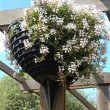
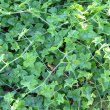
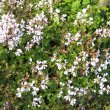
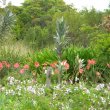
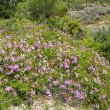



Discuss this plant
Share knowledge, ask a question or give an experience.